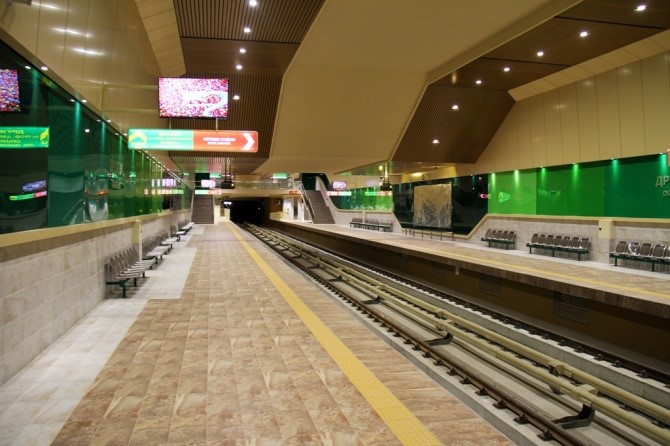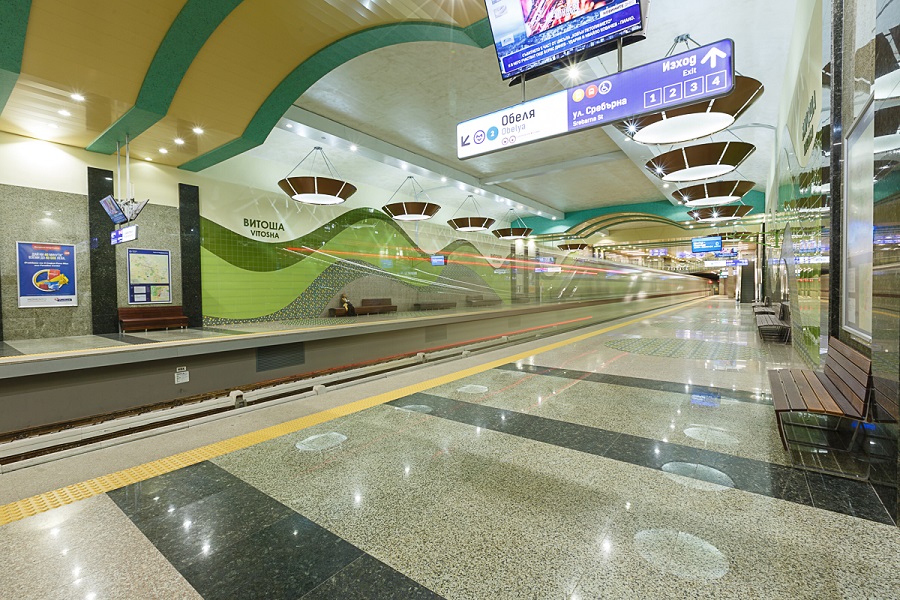Bulgarian capital Sofia ranks among the most beautiful European cities. Its very name comes from the Greek name for “wisdom”, and its origin dates back to a Roman settlement built some 2,800 years ago. The city boasts mild climate and a vast number of historical sites, garnered by unusual recreational opportunities. In 1960s, the city had a population of ca. 500,000, and underwent intense construction. New cozy districts were built, quite remote from the downtown, and in a while the authorities began to contemplate construction of the metro. These times, in the Soviet Union, only cities with population matching or exceeding one million people, were eligible for construction of an underground transport system.
In Sofia, metro construction started in 1979, financed by the state and regional budgets, with a significant contribution from the Soviet Union. Underground construction universally requires huge time an effort, and in Sofia it was hampered by geological conditions. However, by 1982, some tunnels were constructed and two metro stations were about ready. “Perestroika” in the USSR entailed drastic changes in friendly states of the Warsaw Pact, and funding for Sofia Metro halted. In 1989, Bulgarian “Metrostroy” (acronym for “Underground Construction Company”) ceased to exist.

In early 1990s, the construction was recommenced, directly supported by the European Union. In 1998, almost two decades upon the “first pile was put”, the first part of the first diameter was commissioned, comprising five metro stations and spanning 6.5 km from “Slivnitsa” through “Konstantin Velichkov”. The authorities and construction workers deserve praise for the exceptional rates of metro development. Currently, Sofia Metro has three lines with 69 stations in operation and 75 km of tunnels. The number of residents in Sofia exceeds 1.6 mln. Road traffic is usually congested, and at peak hours cars can travel at 10 km/h. Then, high-speed metro transport system enables fast and reliable commuting. It is designed for transportation of more than 1 mln people annually, upon the completion of implementation of the entire system.
Sofia is the only city in Bulgaria to have a metro system.
Construction technologies of Sofia Metro deserve special attention and might provide a valuable insight into success.
1. “Open-cut” stands for digging out pits in the immediate proximity to buildings or walkways. In the pit, underground structures and tunnels are constructed. Then the pit is covered and surfaced. Equipment is installed and finishing works are being done. Hardened structures are usually used, to ensure that no damage could possibly be done by construction works near existing structures. No roofing is being done.
2. “Milanese approach” is applied for urgent surface recovery, up the metro construction facilities. Future walls and splines are constructed in tunnels, with no overall pits. These walls are roofed and then excavation is performed, upon recommencing of surface traffic. Digging is resumed and the remaining facilities are being constructed. With surface traffic in Sofia gaining its momentum, the bulk of the newer metro stations are built “Milanese style”.
3. “Shield tunneling” is used in the center of Sofia, comprising quite a number of archeologically significant artifacts. This approach is intended to prevent destruction of the underground and help sustain buildings above.
4. “Australian tunnel approach” is efficiently employed in comparatively vast areas with limited water inflow. The key is the use of bearing capacity of the land mass, to use it as a protective construction for the tunnel.
5. “Adjusted approach” means land mass development, and construction is performed in five to six stages. It is used in very difficult geological and hydrogeological conditions, in greater depths and vaster cross sections.
Whatever the method, the construction of Sofia Metro is a great engineering feat. Certainly, travelers care less for the intricacies of tunnel construction and strengthening of station halls. They tend to pay attention to the comfort and aesthetics. In Sofia, metro stations are time-representative. Construction cost for a metro station is usually a tiny fraction of 2.5 – 3.0 % of the total project cost. Still, metro stations have a certain cultural value; they get commuters cozy and provide an outline of the metro.

No lush, but the style and individuality of each station – that is what Sofia Metro is about. It also involves the ambient of being on the surface, feeling comfortable and breathing freely.
Each and every metro station features a peculiarity and astonishing variety of elements. Even reinforcement constructions form a part of the interior design. All connections are clearly designed, with quotes from Bulgarian writers. A prime example is “Universitet Station”, featuring references to base-reliefs of what a traveler is expected to see in the city.
In constructing the Serdika Station, remains of a Roman settlement were unveiled, dating at ca. AD. Excavations were done, and the designers of the station incorporated the antique relics into the architecture of the station, perfectly combining three millennia. The station also features an exhibition of antiquities.
All Sofia Metro stations boast ideal cleanliness. No one would ever get the idea of dropping a piece of paper. Trains are six-car, arrivals range from four to 15 minutes, depending on the rush hours and time of day. Cars are Russian-made.

Sofia Metro is much quieter and relaxed than in many more other capitals. Though Wi-Fi is not provided at all stations, for a small payment one can use a PC at some stations. Tickets are affordable. Ten trips by the E-card cost 12 levs, plus $1.6 for the plastic card. One-day metro card costs 4 levs. One-day all-transport cards, including the metro, are also available.
Unsurprisingly, Sofia Metro features escalators. These are energy-efficient and do not operate with no person stepping on. Challenged people (like every other) can use elevators on every station.
Sofia Metro is a relatively young structure, with its highs and lows. Still, it delivers a nice experience of one of the most beautiful and cozy underground traffic facilities in the world. It has been helping reduce road traffic and connect newly built residential areas with the center. With the Metro, the beauty of Sofia has an extra global highlight deserving close attention of tourists and augmenting the capital’s overall appeal.
